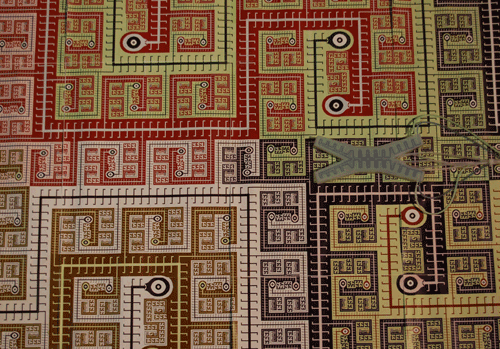Just a year ago, researchers at Harvard University led by George Whitesides developed a new robotic entity: the soft-robot. Now they’ve taken a step further and developed a soft robot capable of camouflaging with its environment.

Soft-robot camouflaging with its environment. (Image via S. Morin, Harvard University)
This soft, camouflaging robot comprises tiny channels embedded inside of silicon rubber, which allows it to move and change color. The device has two different channels. One for movement that is pressurized and inflated with air and another for color-changing capabilities filled with temperature-controlled colored solutions. The color layers developed are flexible and stretchable to allow them to work with soft robots. The lightweight robot requires no power equipment once filled and does not even need a lot of fluid to produce vivid coloration.
According to Stephen Morin, lead author of the paper “Camouflage and Display for Soft Machines,” what’s new about this technology is that “the color layers can control color in both the visible and infrared spectrums simultaneously.” This new concept is referred to as multispectral tailoring.
While others have tested other methods to try and achieve a system that would create a robot closely related to real cephalopods such as octopi and squid, Whitesides, Morin, and the team are the first to use a simple open-ended microchannel to achieve color change in multiple regions.
What can these soft, camouflaging robots do?
They can change their color, shape, and temperature to blend with surroundings; glow through a process of chemiluminescence; and move by pressurization of the channels.
One aspect that will need improvement is speed. While injected with fluid, the robot moves at only 40 meters per hour. Without fluid it can reach up to 67 meters per hour.

The soft robot glowing through the process of chemiluminescence. (Image via S. Morin, Harvard University)
Future applications
A robot like this will not be for commercial sale, but the Department of Defense has taken an interest in it. The Defense Advanced Research Projects Agency (DARPA) foresees the integration of robots in future missions. However, robots are usually very expensive and complex. These silicon-based robots prove to be a positive advancement for DARPA in that they offer a higher level of resourcefulness, efficiency, and cost-effectiveness.
DARPA is not the only group that can benefit from this technology. These robots can potentially aid in the medical field as well. They can be used as realistic models of organs for training and surgical purposes and may be used in prostheses.
The team also suggests potential use in safety situations or rescue missions where the robot could find something and indicate location by displaying bright colors. ■
The video shows a soft-robot walking onto rocks, then being filled with fluid to match the color of the rocks. (Video via : DARPA)
Advertisement
Learn more about Electronic Products Magazine





